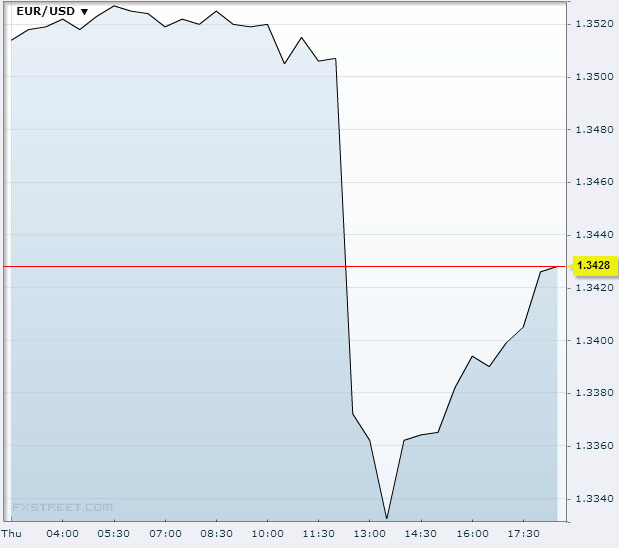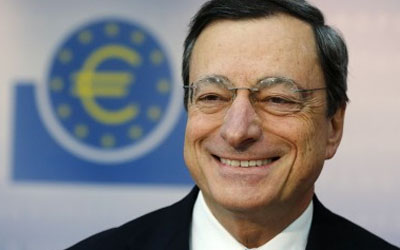A dramatic cut in interest rates, announced by the European Central Bank yesterday afternoon, sent the euro into freefall. The central bank has brought down interest rates by 25 basis points to a historic low of 0.25%, and has extended their fixed rate allotment into 2015.
This decision caught much of the market by surprise, with less than 10% of economists forecasting the move, and an even smaller percentage of investors having priced in the potential rate cut. The upshot of all this is that the EUR/USD plunged nearly 200 pips on the news, dropping from 1.3507 to a low of 1.3332, and was trading around the 1.3400 mark by the close of the European session.

Source: FXstreet
The move is symptomatic of the ECB’s nervousness about the low rate of inflation, and the possibility that it could turn into deflation. At the time of the announcement, ECB president Mario Draghi maintained that there were no signs of deflation, and that the move was intended to shorten the period of low inflation. Yet, with consumer price growth at its lowest ebb for four years, and producer prices falling, there are widespread concerns that the Eurozone economy could end up facing the same problems that Japan has faced with deflation in its recent history.
By lowering the rates this month, rather than waiting for next month, it is clear that the ECB wishes to leave the door open to further easing measures the next couple of months if the situation fails to improve. Although the central bank is fast running out of options for boosting the Eurozone economy, there are still some tools left at their disposal, with Draghi stating that the ECB is technically ready to cut the deposit rate, and previous comments indicating that a further round of LTRO is still on the cards.
With the decline in inflation being stronger than anticipated, and concerns about unemployment and the overall state of the economy growing louder, it is expected that the ECB will lower their growth and inflation forecasts in next month’s ECB staff forecasts. Draghi has been keen to stress that the ECB is likely to do more easing, as the euro will most likely have to be weakened further if deflation is to be avoided. Therefore, it’s unlikely that there will be a significant recovery in the currency in the near to medium term.
The EUR/USD has also been put under pressure by stronger than expected growth in the US economy, with GDP expanding by 2.8% in Q3, up from 2.5% in Q2. Economists had been expecting growth to slow to 2% as a result of the government shutdown, but weaker consumer spending was outweighed by a strong inventory buildup. This also raises the spectre of potential tapering of the Fed’s quantitative easing programme, which was widely expected in September but was delayed due to uncertainty over the debt ceiling. Therefore, we can expect the EUR/USD to continue its downtrend for a number of months, which will at least be good news for European exporters who have been struggling under the weight of a strong euro in the past few months.
Read More:
What is emotionless option trading?
Tradersdna is a leading digital and social media platform for traders and investors. Tradersdna offers premiere resources for trading and investing education, digital resources for personal finance, market analysis and free trading guides. More about TradersDNA Features: What Does It Take to Become an Aggressive Trader? | Everything You Need to Know About White Label Trading Software | Advantages of Automated Forex Trading









